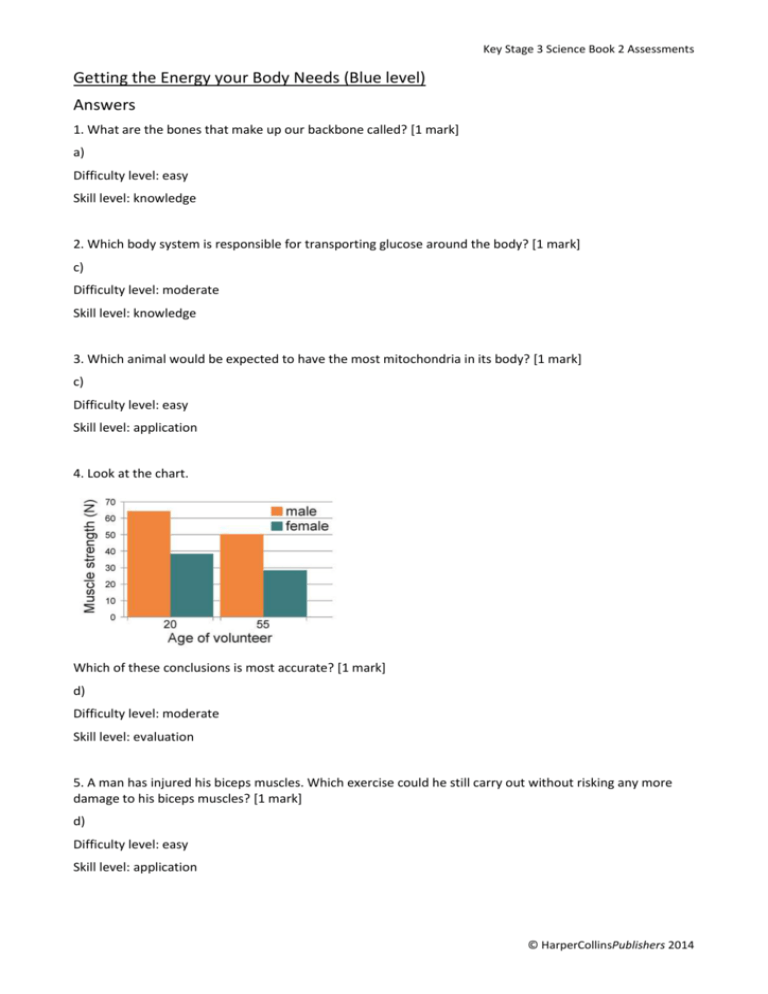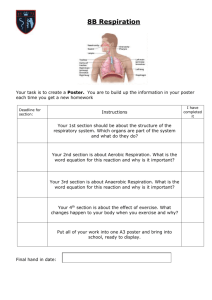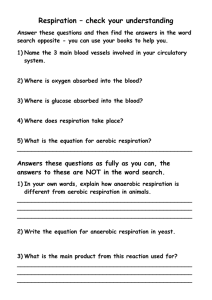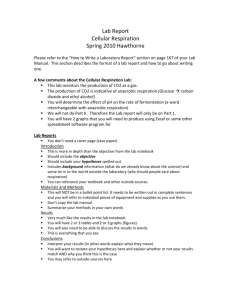Getting_the_Energy_Your_Body_Needs_Blue_Answers
advertisement

Key Stage 3 Science Book 2 Assessments Getting the Energy your Body Needs (Blue level) Answers 1. What are the bones that make up our backbone called? [1 mark] a) Difficulty level: easy Skill level: knowledge 2. Which body system is responsible for transporting glucose around the body? [1 mark] c) Difficulty level: moderate Skill level: knowledge 3. Which animal would be expected to have the most mitochondria in its body? [1 mark] c) Difficulty level: easy Skill level: application 4. Look at the chart. Which of these conclusions is most accurate? [1 mark] d) Difficulty level: moderate Skill level: evaluation 5. A man has injured his biceps muscles. Which exercise could he still carry out without risking any more damage to his biceps muscles? [1 mark] d) Difficulty level: easy Skill level: application © HarperCollinsPublishers 2014 Key Stage 3 Science Book 2 Assessments 6. Remains of an unknown skeleton are found to contain some bones that are curved around an empty space. What was the likely role of these bones? [1 mark] b) Difficulty level: moderate Skill level: evaluation 7. Anaerobic respiration can take place in plants and animals. Match each statement to what it describes. [1 mark] The product of anaerobic respiration in animals Lactic acid The type of alcohol made by anaerobic respiration in plants Ethanol The gas made by anaerobic respiration in plants Carbon dioxide The name for the type of anaerobic respiration that produces alcohol Fermentation Difficulty level: easy Skill level: knowledge 8. Match each type of skeletal problem to its most suitable treatment. [1 mark] Compound fracture Surgery and treatment to close the wound Fine (hairline) fracture Plaster cast of glass fibre Severe fracture Metal pins Arthritis Joint replacement operation Difficulty level: moderate Skill level: knowledge 9. Choose two applications of fermentation. [1 mark] a), c) Difficulty level: easy Skill level: knowledge 10. Animals can carry out both aerobic and anaerobic respiration. Choose two correct statements comparing the two types of respiration. [1 mark] c), d) Difficulty level: moderate Skill level: knowledge © HarperCollinsPublishers 2014 Key Stage 3 Science Book 2 Assessments 11. Explain why we cannot easily see all of the 206 bones when we look at a human skeleton. [2 marks] (the answer should contain the following) 1) Some bones are inside other bones (could explain that bones in the ear are hidden by the skull) 2) Some bones are very small (could give the example of bones in the ear that are only 3 mm long) Difficulty level: easy Skill level: knowledge 12. Suggest why an oak tree needs more energy than a daffodil. [2 marks] (the answer should contain two of the following) 1) Produces more flowers and seeds 2) Produces more new tissue as it grows 3) Needs more energy to absorb sufficient nutrients 4) Larger plant needs more energy to sustain processes Difficulty level: moderate Skill level: application 13. A runner is trying to understand more about the way their body gets energy as they run. Explain to them why they change from using aerobic respiration as they jog to anaerobic respiration as they sprint. [2 marks] (the answer should contain two of the following) 1) As they jog, they can get enough oxygen (to cells) for aerobic respiration 2) As they sprint, they need to produce energy more quickly 3) Anaerobic respiration releases energy more quickly Difficulty level: easy Skill level: application 14. A man has been told to rest his damaged triceps muscles. He decides that he could lift some small hand weights using just his biceps. Explain to the man why he mustn’t use his biceps like this while resting his triceps. [2 marks] (the answer should contain the following) 1) The triceps is used to straighten the arm again after it is bent 2) The biceps and triceps are antagonistic muscles Difficulty level: moderate Skill level :application © HarperCollinsPublishers 2014 Key Stage 3 Science Book 2 Assessments 15. The leg bones of two similar-sized animals are compared. The leg of animal A is made of two bones. The leg of animal B contains one long bone. Based on these findings, explain why animal A can jump further and higher than animal B. [2 marks] (the answer should contain two of the following) 1) Animal A has a leg joint whereas animal B does not 2) Animal A can bend its leg, whereas animal B cannot c) Bending the legs helps with jumping Difficulty level: easy Skill level: application 16. A hospital visitor is surprised to find that patients in a coma are being fed via a feeding tube. Explain why these patients need food even though they are not moving around. [2 marks] (the answer should contain two of the following) 1) They need energy for muscles in the body to work (e.g. heart) 2) They need energy to grow 3) They need energy to keep body temperature constant Difficulty level: moderate Skill level: application 17. Look at these images of bone fractures. One is a simple fracture and the others is a compound fracture. Identify which is which. Compare them and suggest how each should be treated. [4 marks] (the answer should contain four of the following) 1) A fracture is a break of a bone [1 mark] and is treated with a plaster cast [1 mark] 2) With a compound fracture, skin is broken [1 mark] and may require surgery [1 mark] 3) There is a higher risk of infection with a compound fracture 4) The photograph shows a compound fracture and the x-ray shows a simple fracture Difficulty level: easy Skill level: evaluation © HarperCollinsPublishers 2014 Key Stage 3 Science Book 2 Assessments 18. Compare and contrast the structure and roles of tendons and ligaments. [4 marks] (the answer should contain four of the following) 1) They are both made from collagen 2) Fibres in tendons are arranged more loosely OR fibres in ligaments are arranged more tightly 3) Ligaments join bone to bone 4) Tendons join bone to muscle 5) Both form part of the skeletal system 6) Both help us to move our joints Difficulty level: moderate Skill level: knowledge © HarperCollinsPublishers 2014







